The video raised eyebrows in Sweden: couldn’t Prime Minister Ulf Kristersson have avoided the clichés? As he prepared to receive Emmanuel Macron, invited to Stockholm by King Carl XVI Gustaf, for a two-day state visit, on January 30 and 31, Mr. Kristersson published a short clip on Instagram. “Dear President Macron, I look forward to welcoming you to Sweden. But first, let me introduce you to some Swedish specialties and behaviors”, he says, sitting at a table with a cup of coffee and a cinnamon brioche. Before continuing: “In Sweden we have a saying: “Det finns inget dåligt väder, bara dåliga kläder.” »
In French : “There is no such thing as bad weather, only bad clothing. » Everyone knows this adage in Sweden, as it is repeated over and over again by parents who want to convince their children to go outside whatever the weather. It is also a mantra repeated to foreigners who come to settle in the kingdom, so that they can better understand the customs of this small country where the mercury rarely exceeds 20°C.
Lit by large windows, the long corridor which connects the small and large sections of the Snickarbacken kindergarten, in Lund, in the south of the country, is a perfect showcase. On the wall, on both sides of the corridor that opens onto two muddy playgrounds on this rainy February day, hang the children’s outerwear: fleece jackets, waterproof pants and brightly colored overalls, covered in dried mud. On the ground, the boots and padded shoes. And, on a shelf above: boxes where gloves, hats and scarves are stored.
Toddlers muddy from head to toe
At the end of the corridor, the teacher, Cecilia Ekdahl, opens a door which opens onto a small room where a dryer is blowing. This is where teachers hang up the wettest clothes between outings. Because, in Snickarbacken, as in all kindergartens in Sweden, the children play outside every day, whether it rains or snows. Only exception: “When it was really cold, as was the case at the beginning of January, for example, with days when it felt like -20°C, they stayed indoors”specifies the director, Anna Lagerholm.
But, for the children and for the warmly dressed teaching staff, these outings are essential, notes Cecilia Ekdahl: “They need to get some fresh air and exercise. It’s also good for their motor skills. » As for the parents, “They wouldn’t understand if we told them we stayed inside all day” − even if some people grimace when picking up their toddlers, covered in mud from head to toe, in the evening. Logistically, everyone has their own strategy: some children have a change of clothes and alternate between two loads of laundry; the others return to school in the same state the next day, without it shocking anyone.
You have 49.47% of this article left to read. The rest is reserved for subscribers.
